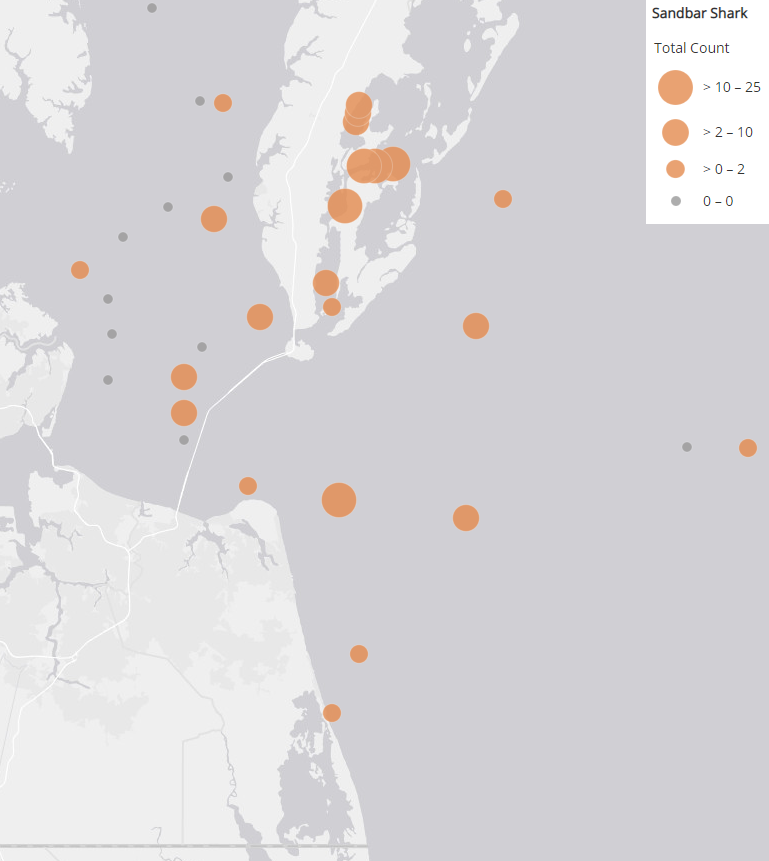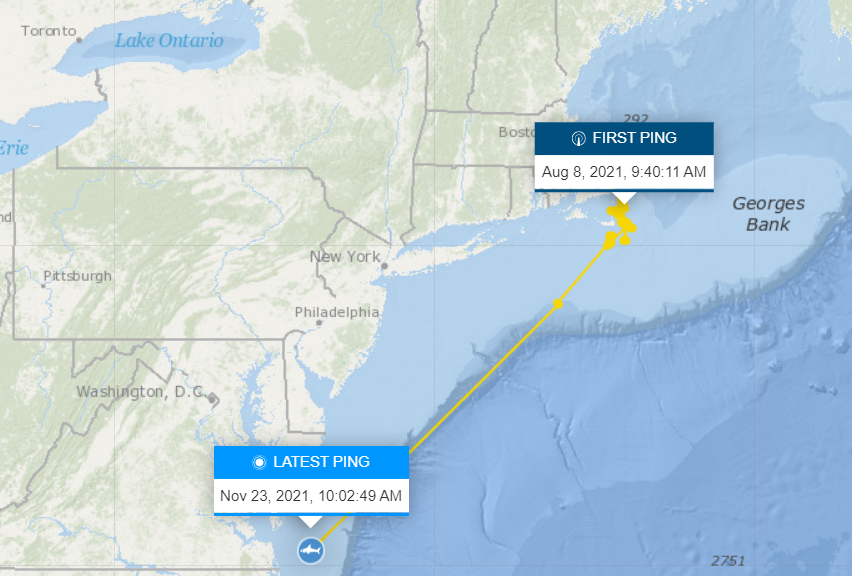
scientists have succeeded in finding Sandbar Sharks when they search at historical fixed stations in the Longline Survey
Source: Virginia Institute of Marine Science (VIMS), VIMS Longline Catch, June 2020

scientists have succeeded in finding Sandbar Sharks when they search at historical fixed stations in the Longline Survey
Source: Virginia Institute of Marine Science (VIMS), VIMS Longline Catch, June 2020
More than more than 50 shark species, including sandbar, sand tiger, smooth dogfish, Atlantic blacktip, spinner, Atlantic sharpnose, and lemon sharks, live in the Atlantic Ocean off the East Coast. Many species feed in bays and estuaries such as the Chesapeake Bay.1
The Sandbar Shark (Carcharhinus plumbeus) is the most common large shark found off Virginia in the Atlantic Ocean and in Chesapeake Bay. Juveniles use the Chesapeake Bay as a nursery, while adolescents and adults feed in both state and Federal waters near the coastline during the summer. They graze along the bottom in waters up to 655 feet (200 meters) deep, capturing fish, mollusks, and crustaceans.
The species migrates south for the winter, after a summer and fall of feeding. Commercial fishermen harvest Sandbar Sharks for their large fins, used by restaurants to make shark-fin soup. Overfishing depressed the population until the state began to manage the species in 1990, and the Federal government began conservation efforts in 1993.2
Six other shark species are common in Virginia waters, and in Federal waters outside the three-mile limit. They are the Smooth Dogfish (Mustelus canis), Atlantic Sharpnose Shark (Rhizoprionodon terraenovae), Dusky Shark (Carcharhinus obscurus), Blacktip Shark (Carcharhinus limbatus), Spinner Shark (Carcharhinus brevipinna), and Scalloped Hammerhead (Sphyrna lewini). Three other species are occasional visitors - Smooth Hammerhead Shark (Sphyrna zygaena), Bull Shark (Carcharhinus leucas), and Tiger Shark (Galeocerdo cuvier).3
Source: Smithsonian Environmental Research Center, Tagging Sharks with the Smithsonian Movement of Life Initiative
Harvesting the Dusky Shark was encouraged in the 1970's and 1980's, when fishery managers thought that would help reduce predation on commercial fish species whose populations had plummeted. After recognizing that the Dusky Shark was at risk of disappearing, a protected zone was created off the coast of North Carolina. Use of bottom longline gear was banned from January through July, when the sharks were thought to congregate the.
By 2020, inventories have revealed that the numbers )of Dusky Shark first grow in the protected zone starting in November, and they migrate north from it in May. Warmer waters from a changing climate may explain the different pattern. Biologists realized that the dates for the ban on bottom longline gear would need to be revised, to protect the population.4
The warming climate is causing southern sharks to expand their range north. At the same time, the harbor seal population is recovering from excessive harvest, and an increasing number of juveniles are spending the winter between December-May in the Chesapeake Bay. Grey seals, harp seals and hooded seals are also found in Virginia waters, and all are prey for sharks.5
The first recorded shark attack in Virginia dates from 1852. A deserter swimming from the USS Pennsylvania was killed by a shark.
Between 1900-2020, there were 19 shark attacks in Virginia waters, and four were fatal. Some attacks were provoked, such as when a blacktip reef shark being revived from sedation at the Virginia Aquarium & Marine Science Center bit the handler.
The most recent fatal attack in Virginia occurred in 2001; a bull shark bit a 10-year old swimming in the Atlantic Ocean at Sandbridge. The most recent attack, which was non-fatal, also occurred at Sandbridge in 2010. A shark bit an 18-year old surfer on the ankle and knee.6
A tourism-related website for Virginia Beach highlights that recreationists face low risk of a shark attack in Virginia waters, while more-southern beaches have a higher risk. The logical conclusion for the reader to draw is that it would be more prudent to book a vacation at Virginia Beach:7
The Virginia Institute of Marine Science (VIMS) began its Shark Survey in 1973. In its first 45 years of catching sharks through 2018, only five great white sharks (Carcharodon carcharias) were found. A non-profit organization, OCEARCH, tags great white sharks and tracks their movements. Using that different technique, OCEARCH has documented regular visits of great white sharks through the waters off Virginia. As the waters cooled in 2021, a 140-pound male named Santiago moved from Cape Cod in August to Virginia Beach in November.8

white sharks like Santiago migrate through the Atlantic Ocean off Virginia
Source: OCEARCH, Shark Tracker